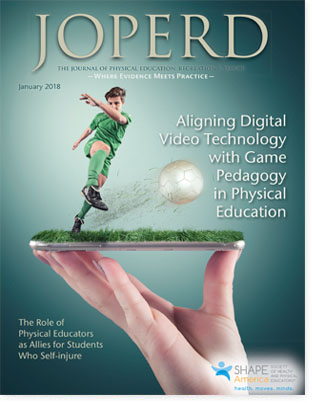 JOPERD Table of Contents
JOPERD Table of Contents
Aligning Digital Video Technology With Game Pedagogy in Physical Education
Jeroen Koekoek, Hans van der Mars, John van der Kamp, Wytse Walinga & Ivo van Hilvoorde

There is a growing interest among physical educators relative to incorporating digital technology in their teaching (Juniu, 2011; Pyle & Esslinger, 2014; Thomas & Stratton, 2006). In part, this willingness is a consequence of digital technology’s already formidable impact on how children (and adults!) today experience games, sports and other physical activities. The use of smartphones, tablets, applications (apps), video feedback, serious (educational) games (Michael & Chen, 2006), and YouTube has contributed greatly to these developments. Student learning, teachers’ daily instructional practices, and preservice preparation programs are all affected by the ever-increasing sophistication of technology tools. Digital technologies influence how children and youth come in contact with sport, how they shape their own “sport identity” (Pot, Schenk, & Van Hilvoorde, 2014), how they acquire movement skills, and how they perceive and evaluate their movement skill on video recordings (Palao, Hastie, Cruz, & Ortega, 2015).
The use of digital technology in physical education differs fundamentally from its use in other school subjects. This is because the learning process in the psychomotor domain is directly observable and public (i.e., it is there to see for both peers and the teacher). Thus digital technology can be utilized to help bring the learning process to life for the learner (Casey & Jones, 2011). However, what remains unclear is how, when and by whom technological apps such as digital video analysis could best be used.
This article is directed to physical education professionals, physical education teacher education (PETE) faculty, and sport pedagogy researchers alike, and it will focus on how digital technology can be used to develop students’ awareness of tactics in game-based lessons. For example, teachers can use video-based feedback to enrich the way they teach game pedagogy. In particular, the analysis of video footage showing tactical aspects of the game may foster higher levels of insightful tactical play and greater participation by students (Harvey & Gittins, 2014).
To read the rest of this article,
click here to download a pdf.